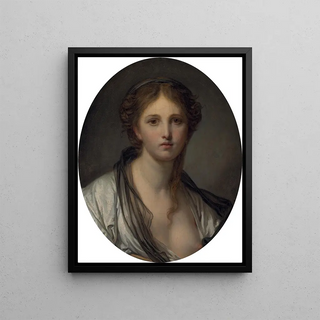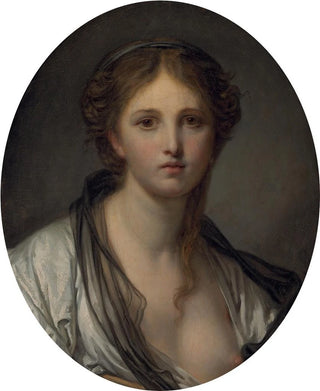Art print | Portrait of a young woman bust with a black scarf - Jean-Baptiste Greuze


View from behind

Frame (optional)
In the fascinating world of art, some works manage to transcend time and capture the very essence of humanity. "Portrait of a young woman in bust with a black scarf" by Jean-Baptiste Greuze is one of those creations that, through its emotional depth, invites us to delve into the subject's intimacy. This painting, emblematic of the 18th century, demonstrates technical mastery and rare sensitivity, revealing a young woman whose gaze, both gentle and contemplative, seems to tell a personal story. The delicacy of her features and the elegance of the black scarf framing her face add a mysterious dimension to this portrait, captivating the viewer and inviting exploration of the nuances of the human soul.
Style and uniqueness of the work
Greuze's style is distinguished by its realistic and intimate approach, far from the academic conventions of his time. In this portrait, he succeeds in marrying the finesse of texture rendering with a subtle color palette, where shadows and lights play a crucial role in expressing emotions. The black scarf, in particular, is a key element of the composition, creating a striking contrast with the young woman's fair complexion. This stylistic choice is not limited to aesthetics; it also symbolizes a certain psychological depth, suggesting a link between femininity and melancholy. Greuze, by capturing this duality, offers us a vision of the world where beauty and sadness coexist, making his work surprisingly modern.
The artist and his influence
Jean-Baptiste Greuze, an emblematic figure of the Rococo movement, mastered his style through a unique vision of genre and portrait painting. Trained at the Royal Academy of Painting and Sculpture, he quickly gained notoriety for his ability to depict human feelings with rare intensity. His influence extends well beyond his era, inspiring many artists from Romantic painting to Impressionism. Greuze also contributed to redefining portraiture by emphasizing the psychological character of

Matte finish

View from behind

Frame (optional)
In the fascinating world of art, some works manage to transcend time and capture the very essence of humanity. "Portrait of a young woman in bust with a black scarf" by Jean-Baptiste Greuze is one of those creations that, through its emotional depth, invites us to delve into the subject's intimacy. This painting, emblematic of the 18th century, demonstrates technical mastery and rare sensitivity, revealing a young woman whose gaze, both gentle and contemplative, seems to tell a personal story. The delicacy of her features and the elegance of the black scarf framing her face add a mysterious dimension to this portrait, captivating the viewer and inviting exploration of the nuances of the human soul.
Style and uniqueness of the work
Greuze's style is distinguished by its realistic and intimate approach, far from the academic conventions of his time. In this portrait, he succeeds in marrying the finesse of texture rendering with a subtle color palette, where shadows and lights play a crucial role in expressing emotions. The black scarf, in particular, is a key element of the composition, creating a striking contrast with the young woman's fair complexion. This stylistic choice is not limited to aesthetics; it also symbolizes a certain psychological depth, suggesting a link between femininity and melancholy. Greuze, by capturing this duality, offers us a vision of the world where beauty and sadness coexist, making his work surprisingly modern.
The artist and his influence
Jean-Baptiste Greuze, an emblematic figure of the Rococo movement, mastered his style through a unique vision of genre and portrait painting. Trained at the Royal Academy of Painting and Sculpture, he quickly gained notoriety for his ability to depict human feelings with rare intensity. His influence extends well beyond his era, inspiring many artists from Romantic painting to Impressionism. Greuze also contributed to redefining portraiture by emphasizing the psychological character of






